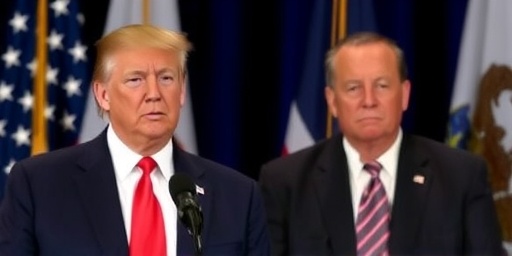In a bold signal to Wall Street and corporate America, incoming President Donald Trump‘s economic team has teased ambitious plans for substantial corporate tax reductions, positioning these tax cuts as a cornerstone of revitalizing the U.S. economy. The announcement, delivered during a high-profile briefing in Washington D.C., has already ignited a surge in stock prices, particularly in the tech and energy sectors, with investors betting on enhanced corporate profits under Trump‘s renewed leadership.
- Trump’s Economic Squad Unveils Vision for Deeper Corporate Tax Relief
- Wall Street’s Immediate Rally: Tech and Energy Stocks Soar on Tax Cut Buzz
- Expert Projections: How Tax Cuts Could Turbocharge 2026 GDP Growth
- Sector Spotlights: Tech Giants and Energy Titans Eye Profit Windfalls
- Looking Ahead: Policy Hurdles and Economic Horizons Under Trump
The tease comes just weeks after Trump‘s electoral victory, as his transition team assembles key advisors to shape the fiscal agenda for his second term. Economists and market watchers are buzzing, with early projections suggesting these moves could supercharge business investments and consumer spending, setting the stage for robust economic expansion.
Trump’s Economic Squad Unveils Vision for Deeper Corporate Tax Relief
At the heart of the excitement is Trump’s selection of a powerhouse economic team, led by figures like Scott Bessent, a hedge fund veteran tapped as Treasury Secretary nominee, and Kevin Hassett, a returning advisor from Trump’s first term known for his advocacy of pro-growth policies. During yesterday’s briefing, Hassett outlined the administration’s intent to slash the corporate tax rate from its current 21%—already lowered from 35% under the 2017 Tax Cuts and Jobs Act—to as low as 15%, echoing campaign promises made by Trump on the trail.
“We’re going to make America the lowest-taxed major economy in the world,” Hassett declared, emphasizing that these tax cuts would unleash a wave of corporate profits by reducing the tax burden on reinvestments and expansions. The plan builds on the 2017 reforms, which Trump credits with adding millions of jobs and trillions to the economy, but goes further by targeting deductions for research and development, energy production, and manufacturing repatriation.
Supporting this vision, the team referenced data from the Tax Foundation, a nonpartisan think tank, which estimates that a 15% corporate rate could boost long-term GDP by 1.5% annually. Critics from the left, including Senate Minority Leader Chuck Schumer, have already decried the proposal as a giveaway to the wealthy, arguing it could balloon the federal deficit by over $4 trillion over a decade, per preliminary Congressional Budget Office models. Yet, proponents counter that dynamic scoring—factoring in growth effects—would offset much of the revenue loss through higher economic activity.
To illustrate the potential scope, consider the 2017 cuts’ impact: Corporate tax revenues initially dropped but rebounded as profits soared, with S&P 500 companies reporting a 31% increase in after-tax earnings in the following year. Trump’s team is betting on a similar, amplified trajectory, with internal memos suggesting incentives for domestic supply chains to counter global disruptions like those from the COVID-19 pandemic and U.S.-China trade tensions.
Wall Street’s Immediate Rally: Tech and Energy Stocks Soar on Tax Cut Buzz
The financial markets wasted no time responding to the tease. On the day of the announcement, the Dow Jones Industrial Average climbed 450 points, or 1.2%, while the Nasdaq Composite—home to tech giants—jumped 2.1%, its best single-day gain in months. Energy stocks led the charge, with ExxonMobil and Chevron shares rising over 3%, as investors anticipate tax breaks for fossil fuel exploration and green energy transitions alike.
Tech behemoths like Apple, Microsoft, and Nvidia saw their valuations swell by billions, driven by expectations of fatter corporate profits from reduced tax liabilities. Nvidia, for instance, whose AI-driven growth has been a market darling, closed up 4.2%, adding $150 billion to its market cap in one session. Analysts at Goldman Sachs attributed the surge to “anticipation of a more business-friendly economy under Trump,” noting that lower taxes could free up capital for AI investments and semiconductor manufacturing onshore.
Broader market sentiment was equally buoyant. The S&P 500 Energy Sector Index rose 2.8%, fueled by Trump’s pro-drilling stance, while the Technology Select Sector SPDR Fund gained 2.5%. Bond yields ticked up slightly as investors shifted from safe-haven Treasuries to riskier equities, signaling confidence in sustained growth. However, not all sectors celebrated equally; renewable energy firms like Tesla dipped initially on concerns over potential subsidy cuts, though Elon Musk’s public support for Trump quickly stabilized the stock.
Market data from Bloomberg shows trading volume spiked 25% above average, with options activity in tax-sensitive stocks like those in the Russell 2000 small-cap index indicating bullish bets. Veteran trader Jim Cramer of CNBC fame called it “a Trump trade revival,” reminiscent of the 2016 post-election rally that saw the S&P 500 gain 5% in a week.
Expert Projections: How Tax Cuts Could Turbocharge 2026 GDP Growth
Analysts are painting an optimistic picture for the U.S. economy, with multiple forecasts now predicting accelerated GDP growth starting in 2026. Moody’s Analytics, in a fresh report, upgraded its baseline outlook to 2.8% real GDP expansion for that year—up from 2.3%—directly crediting the proposed tax cuts. “These reforms could add 0.5 percentage points to growth by stimulating investment and consumer confidence,” lead economist Mark Zandi explained in an interview.
The projections hinge on several factors. First, enhanced corporate profits are expected to drive a capital expenditure boom, with companies like General Electric and Boeing poised to ramp up hiring and R&D. The Peterson Institute for International Economics models suggest that every 1% cut in the corporate rate correlates with a 0.2% GDP lift over two years, potentially pushing unemployment below 3.5% by mid-2026.
International ripple effects are also in play. A stronger U.S. economy under Trump could pressure trading partners like the EU and China to compete on tax fronts, fostering a global race to the bottom—or more accurately, to efficiency. The IMF’s chief economist, Pierre-Olivier Gourinchas, cautioned that while short-term boosts are likely, long-term fiscal sustainability remains a wildcard, especially with Trump’s parallel pledges for tariffs that could inflate import costs.
Delving deeper, sector-specific stats underscore the potential. In tech, Gartner forecasts a 15% uptick in IT spending if taxes ease, translating to $200 billion in new investments. Energy projections from the EIA predict a 10% increase in domestic oil production, bolstering energy independence and export revenues. Even consumer-facing industries like retail could see windfalls, as higher corporate profits trickle down via wage hikes and dividends—phenomena observed post-2017, when median household income rose 4.3%.
Yet, skeptics like those at the Brookings Institution warn of inequality risks, noting that 2017’s benefits skewed toward shareholders. They urge pairing tax cuts with middle-class relief to ensure broad-based growth, a point Trump’s team has acknowledged by floating expansions to the child tax credit.
Sector Spotlights: Tech Giants and Energy Titans Eye Profit Windfalls
The tech sector, already a powerhouse contributing 10% to U.S. GDP, stands to gain immensely from these tax cuts. Companies like Alphabet and Amazon, with effective tax rates hovering around 15-20%, could see their corporate profits swell by 10-15%, according to Deloitte estimates. This influx might accelerate moonshot projects, from quantum computing to autonomous vehicles, positioning the U.S. as a leader in the Fourth Industrial Revolution.
Energy firms, meanwhile, are salivating over targeted incentives. Trump’s plan includes reinstating immediate expensing for drilling equipment, potentially saving majors like Occidental Petroleum $2 billion annually in taxes. The sector, which employs over 6 million Americans, could see a renaissance in shale and renewables, with Trump‘s “all-of-the-above” energy policy blending fossil fuels with nuclear and solar advancements. A recent EIA report highlights how lower taxes correlated with a 20% production surge in the Permian Basin post-2017.
Beyond these frontrunners, manufacturing and finance sectors anticipate secondary boosts. Ford Motor Co. executives have hinted at expanding U.S. plants if tax relief materializes, while banks like JPMorgan Chase project higher lending volumes in a growing economy. Quotes from industry leaders abound: Apple’s CEO Tim Cook stated, “Competitive tax policies are vital for innovation,” while Chevron’s Mike Wirth added, “These changes will fuel American energy dominance.”
Challenges persist, however. Regulatory hurdles, such as ongoing antitrust scrutiny in tech, could temper gains, and energy transitions face environmental pushback. Still, the overall narrative is one of opportunity, with venture capital firms like Sequoia Capital increasing allocations to U.S. startups in anticipation of a profit-friendly landscape.
Looking Ahead: Policy Hurdles and Economic Horizons Under Trump
As Trump‘s inauguration approaches in January, the path to enacting these tax cuts will test Republican control of Congress. With slim majorities in both chambers, reconciliation processes—used successfully in 2017—offer a fast-track, but Democratic filibusters could force compromises. Lobbyists from the U.S. Chamber of Commerce are already mobilizing, projecting that full implementation by mid-2025 could avert a predicted slowdown from high interest rates.
Forward-looking implications extend globally. A turbocharged U.S. economy might strengthen the dollar, impacting exports, but also draw foreign investment, estimated at $500 billion over the next four years by the World Bank. For everyday Americans, the hope is that elevated corporate profits translate to tangible benefits: lower prices from efficient supply chains, more jobs in high-growth areas, and perhaps even wage growth outpacing inflation.
Trump’s team remains bullish, with Bessent teasing additional measures like deregulation to complement the fiscal push. As markets digest the tease, one thing is clear: the stage is set for a dynamic 2025, where tax cuts could redefine the trajectory of corporate profits and economic vitality in the Trump era. Investors and policymakers alike will watch closely as these plans evolve from rhetoric to reality.









